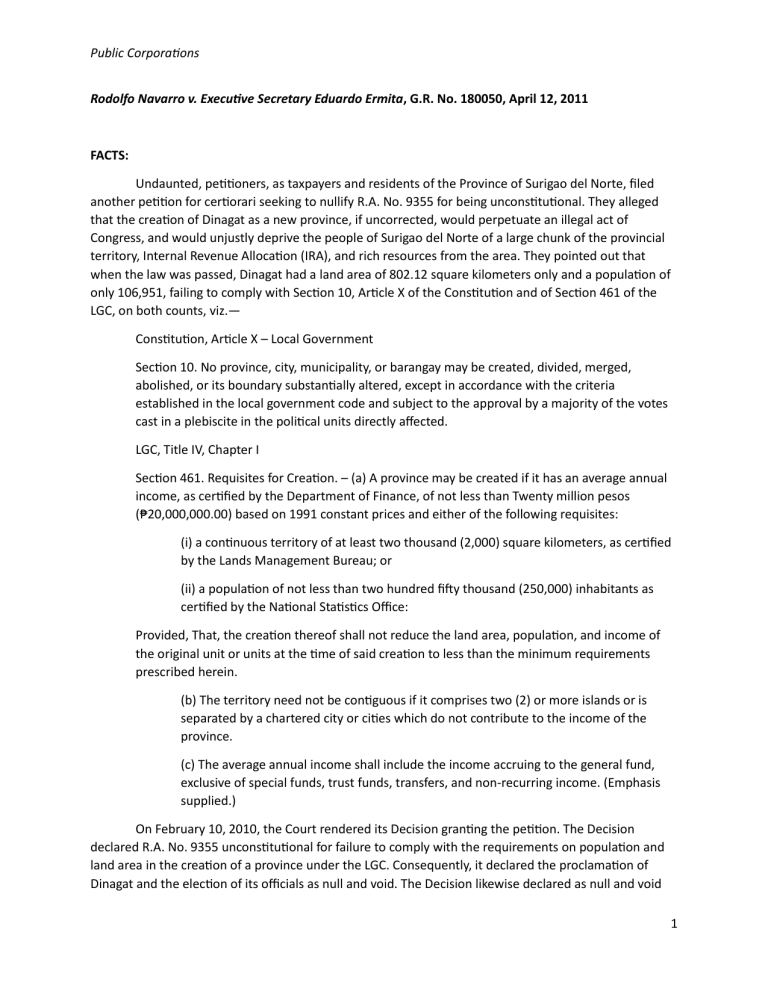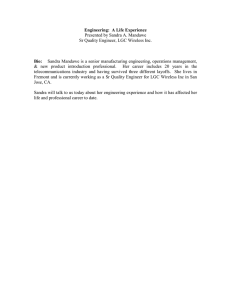
Public Corporations Rodolfo Navarro v. Executive Secretary Eduardo Ermita, G.R. No. 180050, April 12, 2011 FACTS: Undaunted, petitioners, as taxpayers and residents of the Province of Surigao del Norte, filed another petition for certiorari seeking to nullify R.A. No. 9355 for being unconstitutional. They alleged that the creation of Dinagat as a new province, if uncorrected, would perpetuate an illegal act of Congress, and would unjustly deprive the people of Surigao del Norte of a large chunk of the provincial territory, Internal Revenue Allocation (IRA), and rich resources from the area. They pointed out that when the law was passed, Dinagat had a land area of 802.12 square kilometers only and a population of only 106,951, failing to comply with Section 10, Article X of the Constitution and of Section 461 of the LGC, on both counts, viz.— Constitution, Article X – Local Government Section 10. No province, city, municipality, or barangay may be created, divided, merged, abolished, or its boundary substantially altered, except in accordance with the criteria established in the local government code and subject to the approval by a majority of the votes cast in a plebiscite in the political units directly affected. LGC, Title IV, Chapter I Section 461. Requisites for Creation. – (a) A province may be created if it has an average annual income, as certified by the Department of Finance, of not less than Twenty million pesos (₱20,000,000.00) based on 1991 constant prices and either of the following requisites: (i) a continuous territory of at least two thousand (2,000) square kilometers, as certified by the Lands Management Bureau; or (ii) a population of not less than two hundred fifty thousand (250,000) inhabitants as certified by the National Statistics Office: Provided, That, the creation thereof shall not reduce the land area, population, and income of the original unit or units at the time of said creation to less than the minimum requirements prescribed herein. (b) The territory need not be contiguous if it comprises two (2) or more islands or is separated by a chartered city or cities which do not contribute to the income of the province. (c) The average annual income shall include the income accruing to the general fund, exclusive of special funds, trust funds, transfers, and non-recurring income. (Emphasis supplied.) On February 10, 2010, the Court rendered its Decision granting the petition. The Decision declared R.A. No. 9355 unconstitutional for failure to comply with the requirements on population and land area in the creation of a province under the LGC. Consequently, it declared the proclamation of Dinagat and the election of its officials as null and void. The Decision likewise declared as null and void 1 Public Corporations the provision on Article 9(2) of the Rules and Regulations Implementing the LGC (LGC-IRR), stating that, "[t]he land area requirement shall not apply where the proposed province is composed of one (1) or more islands" for being beyond the ambit of Article 461 of the LGC, inasmuch as such exemption is not expressly provided in the law. ISSUE: Whether a local government unit comprised of islands must comply with land area requirement RULING: NO. It must be borne in mind that the central policy considerations in the creation of local government units are economic viability, efficient administration, and capability to deliver basic services to their constituents. The criteria prescribed by the LGC, i.e., income, population and land area, are all designed to accomplish these results. In this light, Congress, in its collective wisdom, has debated on the relative weight of each of these three criteria, placing emphasis on which of them should enjoy preferential consideration. Without doubt, the primordial criterion in the creation of local government units, particularly of a province, is economic viability. This is the clear intent of the framers of the LGC. But it must be pointed out that when the local government unit to be created consists of one (1) or more islands, it is exempt from the land area requirement as expressly provided in Section 442 and Section 450 of the LGC if the local government unit to be created is a municipality or a component city, respectively. This exemption is absent in the enumeration of the requisites for the creation of a province under Section 461 of the LGC, although it is expressly stated under Article 9(2) of the LGC-IRR. There appears neither rhyme nor reason why this exemption should apply to cities and municipalities, but not to provinces. In fact, considering the physical configuration of the Philippine archipelago, there is a greater likelihood that islands or group of islands would form part of the land area of a newly-created province than in most cities or municipalities. It is, therefore, logical to infer that the genuine legislative policy decision was expressed in Section 442 (for municipalities) and Section 450 (for component cities) of the LGC, but was inadvertently omitted in Section 461 (for provinces). Thus, when the exemption was expressly provided in Article 9(2) of the LGC-IRR, the inclusion was intended to correct the congressional oversight in Section 461 of the LGC – and to reflect the true legislative intent. It would, then, be in order for the Court to uphold the validity of Article 9(2) of the LGC-IRR. This interpretation finds merit when we consider the basic policy considerations underpinning the principle of local autonomy. Elementary is the principle that, if the literal application of the law results in absurdity, impossibility, or injustice, then courts may resort to extrinsic aids of statutory construction, such as the legislative history of the law, or may consider the implementing rules and regulations and pertinent executive issuances in the nature of executive and/or legislative construction. Pursuant to this principle, Article 9(2) of the LGC-IRR should be deemed incorporated in the basic law, the LGC. 2




